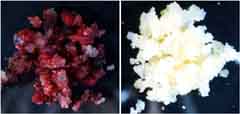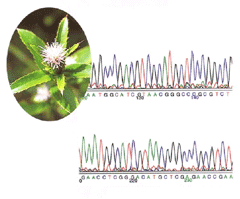Research
1. Clinical Pharmacology of Kampo Medicines
|
| 2. Molecular & Cellular Biology of Plant Secondary Metabolism |
||
| The origin of the most of crude drugs are plants, and their active ingredient are secondary metabolites. It is assumed that the secondary metabolite which plants produce is beyond 50000 kinds and the chemical constitution is extremely complicated and has various bioactivity. Therefore, they are applied to the material of not only new drugs and functional foods, but also pigments, aromatic cosmetics and food additives. For a large quantity of production and stable supply of these secondary metabolites, the production by plant culture cells has been tried. Therefore, we perform the study that aimed at the producive efficiency by doing enzymatic isolation and functional analysis to carry biosynthesis of secondary metabolite on using various plant culture cells. |
||
|
 Culture of Lithospermum erythrorhizon |
|
3. Validation of Natural Medicines
|
 Gene profile of Atractyloidis lancea Name of crude drug: So-jutsu (Atractyloidis lanceae rhizoma) Pharmacology in TCM: Resolving and eliminating dampness with aromatics, dispelling wind, strengthening the spleen |
Recent Publication
| 1. | Tsukamoto, K. et al., Counteractive effect of Paeonia lactiflora root constituent mudanpioside E against suppressive effect of Shoseiryuto-extract on passive cutaneous anaphylaxis reaction in mice |
Journal of Ethnopharmacology. 153(3): 884-889, 2014[Elsevier] |
|
| 2. | Makino, T. et al., 3-Monoglucuronyl-glycyrrhretinic acid is a substrate of organic anion transporters expressed in tubular epithelial cells and plays important roles in licorice-induced pseudoaldosteronism by inhibiting 11β-hydroxysteroid dehydrogenase 2. |
Journal of Pharmacology and Experimental Therapeutics 342(2) 297-304, 2012 [JPET] |
|
| 3. | Nagatoshi, M. et al., An iridoid-specific glucosyltransferase from Gardenia jasminoides. |
Journal of Biological Chemistry 286(37) 32866-32874, 2011.[JBC] |
|
| 4. | Hasada, K. et al., Quantitative determination of atractylon in Atractylodis Rhizoma and Atractylodis Lanceae Rhizoma by 1H-NMR spectroscopy. |
Journal of Natural Medicines 64 (2) 161-166, 2010.[Springer] |
